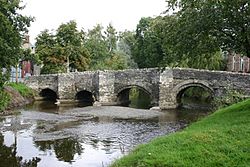River Clun, Shropshire facts for kids
Quick facts for kids River Clun |
|
|---|---|

The river flowing through the town of Clun, in which the historic packhorse bridge is still the only vehicle-carrying bridge.
|
|
| Country | England, United Kingdom |
| Region | West Midlands |
| County | Shropshire, Herefordshire |
| Cities | Newcastle, Clun, Clunton, Clungunford |
| Physical characteristics | |
| Main source | Anchor, Shropshire |
| River mouth | Confluence with River Teme Leintwardine, Herefordshire 119 m (390 ft) 52°21′35″N 2°52′43″W / 52.3598°N 2.8785°W |
| Length | 45.84 km (28.48 mi) |
| Discharge (location 2) |
|
| Basin features | |
| Basin size | 300 km2 (120 sq mi) |
| Tributaries |
|
The River Clun is a river that flows mostly through Shropshire, England. It eventually joins another river called the River Teme in Leintwardine, Herefordshire. The beautiful area around the River Clun is known as the Clun Valley. It is part of the Shropshire Hills AONB, which stands for Area of Outstanding Natural Beauty. This means the landscape is very special and protected.
Contents
Journey of the River Clun
The River Clun starts its journey in a wet, marshy area near a small place called Anchor. This spot is very close to the border of Wales.
From Source to Clun Town
From its source, the river flows towards the east. It passes through the small, historic town of Clun. After Clun, it reaches Aston on Clun. Here, the river changes direction and starts flowing mainly southwards. It curves around the northern side of Clunbury Hill.
The Wider Valley
As the river continues, the valley around it becomes wider. The ground also gets flatter, forming a large flood plain. This is an area of flat land next to the river that can get covered in water when the river overflows.
Rivers Joining the Clun
Several smaller streams and rivers join the River Clun along its path:
- The Folly Brook flows into the Clun near Newcastle.
- The River Unk joins the Clun close to Clun Castle.
- The River Kemp meets the Clun at a place called Oaker, near Aston.
- Closer to the end of its journey, the River Redlake flows into the Clun at Jay.
Where the Clun Ends
Just south of Broadward, the River Clun flows out of Shropshire and into the county of Herefordshire. Here, it finally joins the River Teme. A section of the river south of Broadward Bridge is a Site of Special Scientific Interest, meaning it's important for its natural features.
Places Along the River Clun
Many towns and villages along the river's path have "Clun" in their names. This shows how important the river is to these communities.
- Clun
- Newcastle-on-Clun
- Clunton
- Clunbury
- Aston on Clun
- Clungunford
In the town of Clun, there is a very old bridge called Clun Bridge. This historic bridge still carries the A488 road over the river today. There are also other old bridges and places where people used to cross the river, known as fords, like Broadward Bridge.
Wildlife of the River Clun
The River Clun is a wonderful home for many different kinds of animals. It's a great habitat for:
- Otters
- Salmon
- White-clawed crayfish
- European bullhead (a type of fish)
- Grayling (another fish)
- Brook lamprey (an ancient type of fish)
The river is also famous for being home to the freshwater pearl mussel. These mussels are very special and rare.
Protecting the River's Ecosystem
Unfortunately, the Clun and one of its smaller rivers, the Unk, have faced problems with pollution and too much sediment (like dirt and sand) building up. This makes it harder for the mussels to live there.
The area around the river is mostly countryside. Farmers here raise cattle for beef, sheep for lamb, and grow crops like potatoes and maize.
The River Clun is very important for nature. It is one of only eleven rivers in England where the freshwater pearl mussel lives. It is also one of only three English rivers that has been named a Special Area of Conservation by Europe. This means it's a specially protected area because of its important wildlife.

